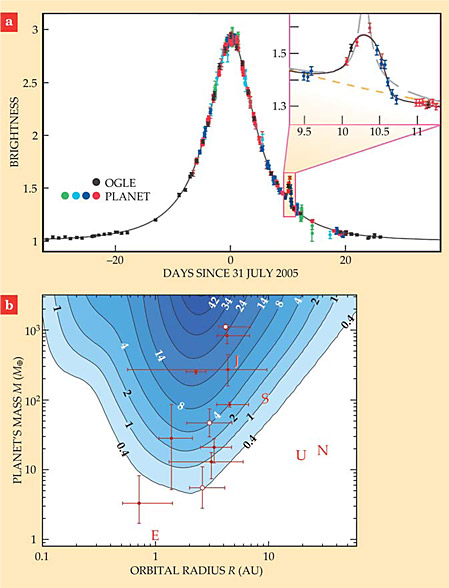Microlensing suggests that our galaxy has more planets than stars
DOI: 10.1063/PT.3.1463
Most of the more than 600 exoplanets discovered to date have been found through Doppler evidence of periodic host-star motion or photometric evidence of transits across a star’s face. Both methods are strongly biased in favor of planets with orbital radii much smaller than Earth’s, which defines 1 astronomical unit (AU). Gravitational microlensing is an alternative technique that’s most sensitive to planets a few AU from their stars. It favors very distant stars and it’s relatively unbiased as to stellar mass. Though microlensing’s discovery rate is still modest, it appeals to those who seek a representative galactic survey of planets with orbits like those of the solar system.
Gravitational bending of light is a central feature of general relativity. In a typical microlensing event, a foreground lensing star passing close by our line of sight to a background star produces milliarcsecond bending that focuses the background star so that it brightens over several weeks. Rarely, a planet several AU from the lensing star reveals itself by a short blip on the brightness curve as it too crosses the sight line (see the figure’s panel a).

Microlensing planet search. (a) The brightness curve of a distant lensed star discovered by the OGLE team and followed up by the PLANET network.

Because planetary blips typically last less than a day, finding and measuring them usually requires a two-tier strategy. First, a wide-field survey team, such as the OGLE collaboration based at the University of Warsaw, images the same star-crowded field night after night in search of the one in a million that’s brightening. When the team finds one, it alerts one of several global networks of telescopes that then monitor the star round the clock for a telltale blip. If the blip is well measured, it yields the planet’s mass M and orbital radius R. Since that strategy was initiated in the late 1990s, many thousands of stellar microlensing events have yielded only about two dozen planet sightings.
Now the PLANET telescope network, led by Jean-Philippe Beaulieu (Paris Institute of Astrophysics), reports an analysis of six years of its search for planets. 1 Translating planet sightings into an estimate of the galactic abundance and mass distribution of planets requires a careful determination of detection efficiency as a function of M and R. And that, in turn, requires adherence to a consistent, well-defined search protocol. So the PLANET analysis limits itself to the years 2002–07, after which innovations led to protocol modifications.
The only three planets discovered by PLANET during that period are plotted in panel b, together with eight discovered during the same period by other networks with protocols of their own. The plot’s contour lines indicate detection efficiencies calculated for PLANET’s six-year survey. Heavier planets are easier to detect. The survey’s mass-detection threshold was about 5 Earth masses (M⊕).
The PLANET team estimated the true galactic distribution of planet masses essentially by dividing its observed M and R distribution by the detection-efficiency function and then integrating over R. In seeking the best analytical fit for the galactic distribution, the team augmented its own meager harvest by taking account of fits by other networks to planets they found. 2
Despite the increase of detection efficiency with increasing M, the density of points in panel b tends the other way. Thus the PLANET team concludes that over the R range 0.5–10 AU, a region largely unexplored by Doppler and transit searches, the galactic planetary-mass distribution falls with increasing mass roughly like M−0.7. In particular, 62 ± 36% of all stars harbor super-Earths (5–10 M⊕); 52 ± 25% have Neptunian middleweights (10–30 M⊕); and 17 ± 7% have Jovian planets heavier than 100 M⊕.
On average, the team concludes, every star has 1.6 planets in the survey’s M and R sensitivity range. “So in the Milky Way,” says Arnaud Cassan, who led the analysis, “planets around stars seem to be the rule rather than the exception.”
References
1. A. Cassan et al., Nature 481, 167 (2012). https://doi.org/10.1038/nature10684
2. A. Gould et al., Astrophys. J. 720, 1073 (2010). https://doi.org/10.1088/0004-637X/720/2/1073
3. J.-P. Beaulieu et al., Nature 439, 437 (2006).https://doi.org/10.1038/nature04441




